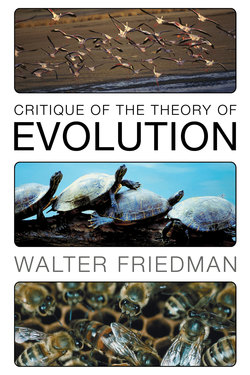Читать книгу Critique of the Theory of Evolution - Walter Friedman - Страница 13
На сайте Литреса книга снята с продажи.
8 : Anthropology
ОглавлениеAnthropologists are among the staunchest defenders of the evolutionary theory. This comes as no surprise, for their livelihood depends on it! But anthropologists use a methodology that is even worse than the one used by biologists. It starts with a definition of human beings that defies all rules of logic. This definition consists of several parts; we’ll go over each of them.
1) Only human beings can use objects that are not part of their body to accomplish a multitude of tasks.
Nothing could be further from the truth; for example, crows use sticks and stones to procure food that is otherwise impossible to get. Anyone who likes to watch TV channels that feature wildlife knows how crows operate.
2) Human beings are the only ones capable of drawing pictures of their surroundings.
There are pictures of flowers and trees drawn by elephants living in Thailand; some of these pictures are even posted on the Internet.
3) Animals are afraid of fire; only human beings can sit next to it.
Actually, this is an urban legend. Recent evidence suggests that certain types of animals, including the fox, are not afraid of fire.
4) Only humans use fire to cook food.
This is true, of course, but anthropologists go a step further by suggesting that “human ancestors,” including the Cro-Magnon, were using fire to cook their supper. However, forensic experts disagree by saying that it is simply impossible to ascertain what kind of food was used in that era because the time span between then and now is simply too large for us to draw any conclusion.
5) Humans are the only species who possess highly evolved linguistic skills.
But anthropologists confuse two different things; it would be helpful to sort them out. To start with, each animal species, not just humans, has its own language—this is a well-known fact. Human languages are different from animal languages in one aspect—they are capable of conveying abstract concepts while animal languages deal with concrete information only. There is strong evidence that prehistoric beings who left paintings on the walls of their caves did not have a language capable of dealing with abstract concepts. This means that prehistoric beings were, in fact, animals and not human ancestors.
6) Only human beings can manufacture clothes.
This is correct, of course; however, there is no evidence that prehistoric beings were wearing any clothes. Prehistoric beings are depicted in biology textbooks wearing some kind of fur clothing, but this is pure artists’ fantasy. It is impossible to tell what kind of garment, if any, they were wearing because garments get destroyed after enduring millions of years of harsh conditions. All that is left are the bones of prehistoric beings and their primitive weapons.
7) Only humans are bipedal and use their hands for manual labor.
The kangaroo is bipedal too, and it uses its hands to get its babies in and out the pouch. There were also reports in the media about an Australian joker who taught his kangaroo how to fight on a boxing ring. Besides, it is not clear if the prehistoric beings were bipedal. For example, some of them had a leg structure very similar to that of the kangaroo. This finding suggests that they were moving in long jumps. Usually, anthropologists compare the length of the arm to the length of the body and if the arms are relatively short, they conclude that a species is bipedal. But this reasoning is not without a flaw—there have been reports of humans who were raised by animals and were able to move on all fours faster than professional sprinters.
Every science begins with the measurement. Anthropologists perform all kinds of measurements on the skeletons of prehistoric beings, then form various ratios such as the ratio of foot length to body length, nose length to head length, hip width to body length, and so on. After that, the average value of each ratio is computed and compared to its human counterpart. Then anthropologists happily declare that prehistoric beings are, indeed, human ancestors because the differences ratios between prehistoric beings and humans is very small. But what does “very small” really mean? Is it 0.46%? Or 3.7%? Or 10.2%? Or 24.9%? Is it possible to make the following determination: if the difference between the ratios is less than or equal to 12.6% then the prehistoric species in question is a human ancestor; otherwise, it is not? It is highly unlikely that even anthropologists would make such an idiotic assessment. There is no theory or even a hypothesis behind these measurements, which makes them completely useless. The only proof that prehistoric beings are human ancestors would come from establishing that they had human blood types. But skeletal remains give no indication of blood type.
Anthropologists face another insurmountable problem that could be summed up in the question, Was the transition from one type of prehistoric being to another abrupt or gradual? Abrupt transitions are like those horror movies with ugly-looking extraterrestrial babies shooting out of human mothers. Luckily, all geneticists agree that such a transition is impossible. What if the transition was gradual? This would indicate the existence of transitional species, but so far anthropologists have discovered none.
